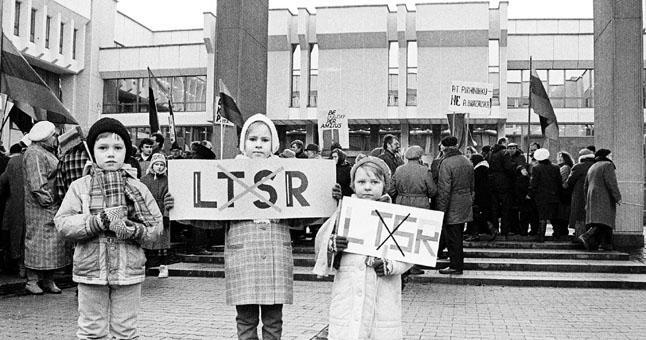
Lithuanian History: Independence (1989-91)

Figure 1.--Here three Lituania children are celevrating the demise of the Lietuvos Tarybų Socialistinė Respublika (LTSR--Lithuanian Soviet Socialist Republic) and the independence of their country. Notice how they have crossed out the TR, leaving LR for Lithuanian Republic. The photograph is undated, but was probaly taken (January 1, 1992). This was the first day after the disolution of the Soviet Union.
|
|
The Soviet Union sought to destroy Lithuanian national sentiment. Stalin ordered the NKVD to murder and deport many ethnic Lithuanians. He also ordered the movement of ethnic Russians into Lithuania. After de-Stalinizatiin, the deport of Lituanians ceased, but ethnic Russians continued to move into Lithuania, atracted bybthe relatively high living stnadards. These were trendsthroughout all three Soviet baltic trpublics. The KGB which replaced the NKVD was less murderous but till brutally effective. Any expression of Lithi=janian nationalist sentiment got one arrested as well as exposure to other sanctions. KGB repression began to weaken with the Heksinki Accords and the Jewish Refusniks (1970s). Lithuanian nationalists began to test the waters, but continued to be arrested. This began to change when Mikhail Gorbachev became General Secreatru of the Soviet Communistb Party (1985). Brought up in the Soviet Union he actually believed that Communism was a superior system and could be reformned. And he though that natiinlist forces could be convinced with reasom--expaining glasnost and perestroika. He had no idea he was letting the genie out of the bottle. Once he realised what he had done, he was unwilling to use force to recork the bottle. The Reform Movement of Lithuania (Lietuvos Persitvarkymo Sąjūdis), is the political organisation which led the Lithuanian struggle independence in the late 1980s and early 1990s. Sąjūdit was founded (1988), and was led by Vytautas Landsbergis. Its goal was to reinstate of the inter-War independent Lithuanian Republic. The Lithuanian independence movement reemerged from the shadows as Soviet leader Gorbechov instituted policies allowing greater freedom of speech and actual free elections (1980s). By all accounts he was surprised at the level of anti-Soviet feeling that was let loose. The NKVD/KGB had supressed the expresion of nationalist sentiment, but not the soul of the Lithuanian people. This was made apparent by the extrodinary Baltic Way demonstration (August 23, 1989). The date was significant--the 40th Anniversary of the infamous NAZI-Soviet Molotov-Ribbentrop Pact. Vytautas Landsbergis, the non-Communist head of the largest Lithuanian popular movement (Sajudis), was elected president (1990). On the same day that Landsbergis was elected, the Lithuanian Supreme Council rejected Soviet rule and declared Lithuania's independennt. The Act of the Re-Establishment of the State of Lithuania or Act of March 11 (Aktas dėl Lietuvos nepriklausomos valstybės atstatymo) was the declaration by the Lithuanian Soviet Socialist Republic (March 11, 1990) signed by all the members of the Supreme Council of the Republic of Lithuania led by Sąjūdis. The Act emphasized restoration and legal continuity of the interwar Lithuanian republic (1919-40) which had been supressed by the Soviet Union (June 1940). The Supreme Council decided that Lithuania's original declaration of independence (1918) was still valid. The Act was presented as a reassertion of an independence that still legally existed under international law. It was based on the premise that Prsident Smetona's resignation was folrced by the Soviets and not valid. Merkys' Coomunist takeover of the presidency was thus illegal and unconstitutional. Lithuania thus took the position that all subsequent acts culminating in the Soviet 1940 annexation were ipso facto void. Lithunaia's act was the first time that an occupied state suceeded in declaring independence from the imploding Soviet Union. It was the first Baltic republic to declare independence. Confrontation with the Soviet Union ensued along with economic sanctions as Gorbechov reqjected the use of force. The Soviets lifted the econonic sanctions after both sides agreed to a face-saving compromise. Lithuania's independence was confirmed with the dissolution of the Soviet Union (1991).
CIH -- Cold War

Related Baltic Pages in the Boys' Historical Web Site
[Estonia]
[Finland]
[Latvia]
[Lithuania]
[Prussia]
Related Chronolgy Pages in the Boys' Historical Web Site
[The 1880s]
[The 1890s]
[The 1900s]
[The 1910s]
[The 1920s]
[The 1930s]
[The 1940s]
[The 1930s]
[The 1940s]
[The 1950s]
[The 1960s]
[The 1970s]
[The 1980s]
Related Style Pages in the Boys' Historical Web Site
[Smocks]
[Long pants suits]
[Knicker suits]
[Short pants suits]
[Socks]
[Eton suits]
[Jacket and trousers]
[Blazer]
[School sandals]
[School smocks]
[Sailor suits]
[Pinafores]
[Long stockings]
Navigate the CIH Cold War Section:
[Return to the Main Lithuanian history page]
[Return to the Main Lithuanian country page]
[Return to the Main European country history page]
[Return to the Main European country page]
[Return to the Main European Cold War page]
[About Us]
[Assessment]
[Biogrphies]
[Countries]
[Communism]
[Culture]
[Decolonization]
[Economics]
[Famines]
[Fashion]
[Freedom]
[Hot wars]
[Human rights]
[Inteligence]
[Mass killing]
[Military]
[Pacifism]
[Phases]
[Science]
[Totalitarianism]
[Bibliographies]
[Contributions]
[FAQs]
[Images]
[Links]
[Registration]
[Tools]
[Return to the Cold war Home page]
[Return to the 20th century wars and crises]
Created: 2:51 AM 8/24/2019
Last updated: 2:51 AM 8/24/2019



